Radish Benefits, Usage, Dose, Side Effects
Radish is useful in treating diabetes, fever, cold, cough, asthma, allergic conditions, throat disorders. Its flowers, fruit and seeds are also used for medicinal purpose. Fresh radish is one among those substances advised to be had on daily basis, as per Ayurveda.
Botanical name- Raphanus sativus Linn.
Family- Brassicaceae (cruciferae)
Table of Contents
Home remedies
By Dr MS Krishnamurthy MD (Ayu), PhD
Radish possesses sweet mixed pungent taste with a lot of juice followed with fibre content it is appreciated in the treatment of constipation and haemorrhoids quite effectively. Ayurvedic classical literature as well as the modern dietetics recommend radish in jaundice, hemorrhoids, indigestion, constipation, urinary disorders, asthmatic conditions, diabetes, skin diseases, fatty liver conditions etc .
Mulakarishtha, Kanjika, Mulaka kshara etc are the unique Ayurvedic medicines containing Radish as main ingredient.
For obesity
1. Radish water in obesity:
1-2 big radish roots are chopped well. This is added to 3-4 cups of water and kept for 1-2 hours. Later it is filtered and throughout the day this water is used for drinking. This helps to reduce the body weight.
For cholesterol
2. Radish fresh juice with lemon for bad cholesterol:
Half cup of radish juice is is mixed with equal quantity of water and a spoon of lemon juice. This is taken in empty stomach daily for 30-40 days. This reduces the bad cholesterol significantly.
Read related: 47 Good Foods And Home Remedies To Reduce High Cholesterol
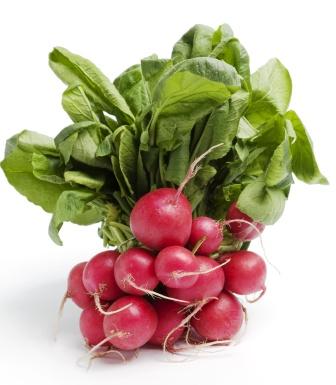
For eyecare
3. Radish leaf juice in eyecare and nightblindness:
Fresh and green leaves of radish are taken and on crushing, juice is obtained. This juice is taken in fresh form in the dose of 40-50 ml twice daily, before food. This is considered good for eyes, relieves burning, itching and excess lacrimation. It is also told to be useful in night blindness.
In leucoderma
4. Radish seed oil in leucoderma:
1-2 teaspoon of radish fruit pieces, 50 ml of radish juice is cooked with 100 ml of sesame oil. Cooking is continued till all the moisture is emptied from the oil. Then it is filtered and stored.
Regular application of this oil over the lesions of leucoderma has good benefits followed with suitable internal medication.
Read related: Vitiligo: Ayurvedic Treatment, Medicines, Herbs, Remedies
As skin detox
5. Radish fine paste as skin detox :
1-2 roots of radish is taken and made into fine paste. This is applied over the skin/face. This is retained for 15-20 minutes and washed thoroughly (avoid this if the skin is sensitive to radish and if you develop allergic rashes)
This rehydrates and detoxifies skin.
Radish – One vegetable; but several health benefits!
Click to consult Dr MS Krishnamurthy MD (Ayu), PhD
Vernacular names
Names in different languages:
Hindi name- Muli, Murayi
English name-Radish
Kannada name – Moolangi
Tamil name – Vellai, Mullangi
Telugu name- Mullangi
Farsi name – Tukh, Turba
Bengali name – Moola
Marathi name – Muli
Arabian name – Fajal, Hujal
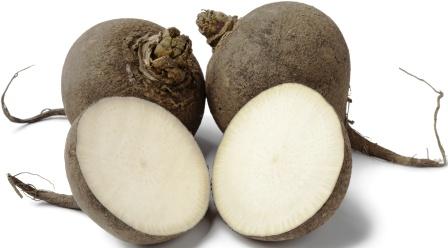
Sanskrit synonyms
Hariparna – having green leaves
Mruttika Kshara – It has Kshara qualities (scraping), found underneath ground.
Neelakanda, Mahakanda, Hastikanda
Ruchishya – improves taste
Dirgapatrika – It has long leaves
Shangamula – White coloured root
Ksharamula – Root is used to prepare Alkali
As per Bhava Prakasha,
Small radish – Bala Moolaka – Shala Markataka, Visra, Shaleya, Marusambhava, Chanakya Moolaka
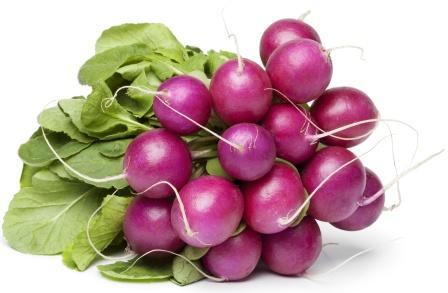
Classical categorization
Kaiyadeva Nighantu – Oshadhi Varga
Dhanvantari nighantu – Karaveeradi Varga
Bhava Prakasha – Mishra Prakarana, Shaka Varga
Raja Nighantu – Moolakadi Varga
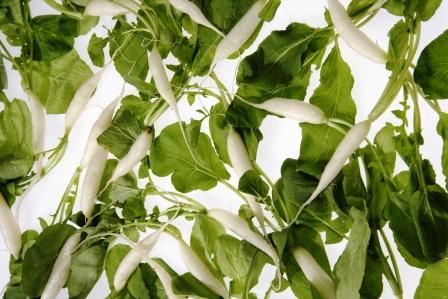
Chemical constituents
Seeds(-) sufloraphene, Sitostreol, Stearic acid, Castasterone and brassinolide
Leaves- P-coumaric, ferulic and caffeic acids.
The root contains many alkaloids, glucosinolates, brassinosteroids, and flavonoids.
Types
Kaiyyadeva Nighantu and Bhava Prakasha mentioned about 2 types of Radish –
Bala Moolaka – small variety
Mahat Moolaka – bigger variety
DN and Ra. Ni – 2 types Mulaka and Chanakya mulaka
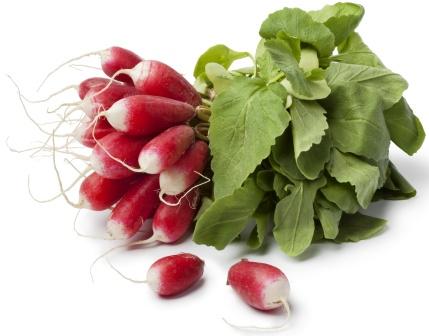
Medicinal properties
Guna-Laghu – Light to digest
Rasa (taste) – Katu (pungent), Tikta (bitter)
Vipaka- Katu – undergoes pungent taste conversion after digestion
Veerya – Ushna – hot potency
Effect on Tridosha: Balances all the three Doshas.
Properties of radish as per Bhojana Kutuhalam
The radish called bana is pungent in taste and hot in potency, It imparts taste and stimulates the digestive fire.It treats gulma, vata and kapha related disorders, worm infestation and it is grahi and guru.
Young radish is hot in potency, sharp and penetrating in nature, bitter, sweet and pungent in taste. Promotes urine production and checks excessive urine production. Treats shwasa(dyspnoea), hemorrhoids, cough, gulma, weakness, ophthalmic disorder and specific colicky pain. It is good for throat, imparts taste and cures disorders with excretion.
In twelfth chapter it is said that the fresh leaves of mulaka is light, promotes digestion, improves taste perception and is hot in potency. Those which are cooked in oil alleviates all the three dosha and without cooking it aggravates kapha and pitta dosha.
Sanskrit verse
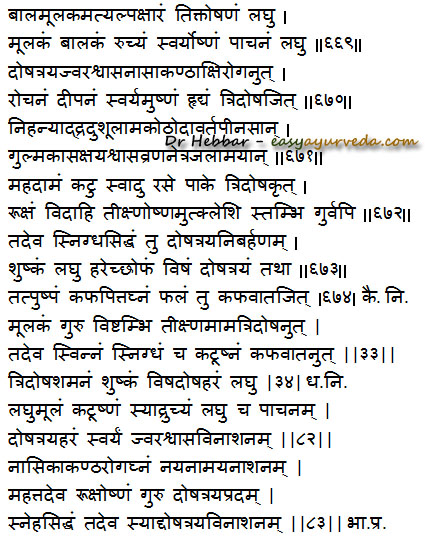
Benefits
Radish benefits as per Ayurveda:
Radish is used to prepare fermented liquid products called as Shandaki. and Kanjika.
Radish contains 657 picograms / gram of melatonin.
Bala Moolaka
Bala Moolaka – Small variety of radish:
Atyalpa Kshara – has less scraping effect
Tikta – bitter taste
Ushana – hot in nature
Ruchya – improves taste, useful in anorexia
Svarya – Improves voice
Pachana – digestive
Laghu – light to digest
Tridoshahara – Balances all the three Doshas
Indicated in
Jwara – fever
Shwasa – asthma, respiratory disorders involving difficulty in breathing
Nasaroga – diseases of nose
Kantha Roga – Throat disorders
Akshiroga – eye disorders
Rochana – improves taste, appetizer
Deepana – improves digestion strength
Hrudya – cardiac tonic, good for heart
Dadru – ringworm
Ama – a product of altered digestion and metabolism
Shoola – abdominal colic
Kota – Urticaria
Udavarta – bloating
Peenasa – rhinitis
Gulma – abdominal tumor, distension
Kasa – cold, cough
Kshaya – tuberculosis, chronic respiratory diseases,wasting of muscles
Vrana – ulcers, wounds
Maha Moolaka
Big Variety – Maha Moolaka
Katu – Pungent
Swadu – Sweet
Swadu Paka – Undergoes sweet taste conversion after digestion
Tridoshakrut – imbalances (vitiates) all the Three Doshas.
Rooksha – dry
Vidahi – Causes burning sensation
Teekshna – Strong, piercing
Ushna – hot
Utkleshi – causes nausea
Stambhi – Causes constipation
Guru – heavy to digest
The bigger variety when processed (fried) with oil is Tridoshahara – Balances all the three Doshas.
Dry radish
Dry radish is prepared by shade drying of the whole radish or its pieces. It is dried for 3 – 7 days. Radish can also be dried in dehydrator trays at 125°F (51.66 degree C) for about 7-12 hours. With dry radish, many dishes such as Mumallaengi, spicy sauce, Mumallaengi Muchim (dry radish special salad) etc. are prepared. Dry radish is available in the market in the name of Mula ko Sinki.
Dry Radish qualities and benefits:
Laghu – light to digest
indicated in-
Shopha – swelling and inflammatory conditions
Visha – toxic condition
Dosha Trayahara – Balances all the three Doshas, mainly Vata and Kapha dosha.
Dry radish for hemorrhoids:
If there are no secretions from hemorrhoids, sesame oil is applied over the mass. Then, dry radish is taken in a cloth pack, heated and local fomentation is given. This is done to relieve pain, swelling and the size of the mass. (Charaka Samhita Chikitsa Sthana, 14th chapter)
Dry radish soup for Kaphaja Grahani:
For irritable bowel syndrome associated with low digestion strength, heaviness, excess salivation, mucus discharge etc, dry radish soup mixed with spices like pepper and ginger is administered. (Charaka Chikitsa Sthana 15th chapter).
Radish flower, fruit, seed
Radish flower:
Kapha Pittaghna – Balances Kapha and Pitta Dosha.
Radish fruit:
Kapha Vatajit – Balances Kapha and Vata Doshas.
Radish seed is useful in productive cough, digestive, bloating. It is mild purgative, useful in constipation and a very good diuretic.
Its seed paste is administered in a dose of 1 – 3 grams per day to treat amenorrhea.
Dose
Radish juice – 25 – 50 ml, in divided dose per day
Seed powder: 1 – 3 grams
Different uses
Moolaka for Swedana (sweating treatment) –
Radish is one among the herbs used in Nadi Sweda (Charaka Sutrasthana 14th chapter). It is boiled in a pot along with other herbs and the steam generated is directed towards particular part of the body.
Radish for hemorrhoids, fissure:
Having radish as a regular vegetable in daily diet is very useful for people with hemorrhoids and constipation. It not only makes the bowel movements easy but also heals the fissure.
Home remedy for bloating and fullness of abdomen
Intake of boiled barley along with radish juice + a teaspoon of ghee is useful in relieving bloating and gaseous distention of abdomen. Charaka Chikitsasthana 5th chapter.
Research
White radish on liver toxicity
Antilithiasic and Hypolipidaemic Effects
Anti-diabetic effect of root juice
Side effects
Consuming fish with radish is contra-indicated.
Milk should not be consumed soon after having radish.
Radish along with black gram is forbidden as per rules of wrong food combinations.
Interaction with medicines, supplements
Can this be used while taking Homeopathic medicine?
Yes. This product does not react with homeopathic medicine.
Can
this medicine be continued while taking supplements like multivitamin tablets,
Omega 3 fatty acids etc?
Yes. Generally, this product goes well with most
of the dietary supplements. However, if you are taking more than one product
per day, please consult your doctor for an opinion.
With western
medicines
Seek your
doctor’s advice if you are taking this product along with other western
(allopathic / modern) medicines. Some Ayurvedic herbs can interact with modern
medicine.
If both Ayurvedic and allopathic medicines are advised together, then it is
best to take Allopathic medicine first, wait for 30 minutes and then take the
Ayurvedic medicine.
Ayurvedic medicines
Ayurvedic medicines with radish as ingredient:
Moolaka Kshara – used in the treatment of difficulty in urination and urinary calculi
Moolakadi Kashaya – used in treating skin diseases in children. It also heals wound quickly.
Shushka Mulaka Taila – herbal oil used in treatment of external edema and inflammation due to injury etc
Sarshapadi Pralepa – Herbal paste, used for external application to treat inflamed cysts, lymph nodes etc.
The reference of radish is found in all the primordioal Ayurvedic texts like Charaka samhita, Sushruta samhita, Vagbhata samhita etc.
According to Acharya Vagbhata (AH sutrasthana 6th chapter-103-105)
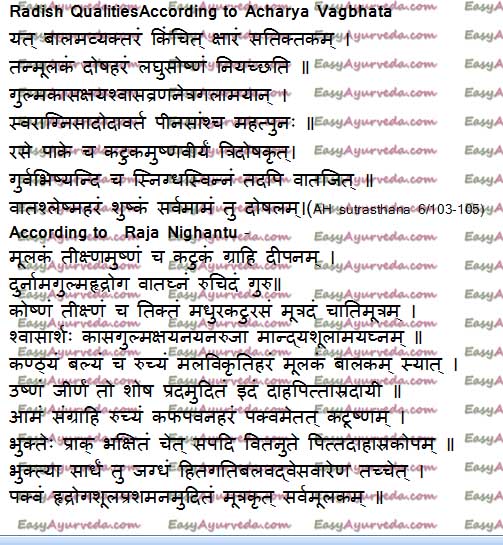
Tender radish :
It is alkaline mixed bitter in taste, balances all three doshas, light for digestion and hot by quality.
It is useful in gaseous tumors, cough, emaciation, breathlessness, wounds, eye disorders, throat disorders, hoarseness of the voice, indigestion, abdominal distention, rhinitis etc.
Matured radish:
It is pungent in taste and metabolic change (Katu rasa and vipaka). It is hot in potency and aggravates all three doshas.
Partially cooked radish or fried radish:
It is heavy for digestion, blocks the channels due to increased secretion, unctuous, pacifies vata.
Raw radish:
Aggravates all three the doshas
Same is elaborated in Raja Nighantu as below-
Raw radish:
It is hot, penetrative, bitter mixed sweet and pungent taste and diuretic. It is useful in urinary disorders, breathlessness, hemorrhoids, cough, gaseous tumors, emaciation, eye disorders, indigestion, abdominal pain etc.
Tender radish:
It is good for throat, energizer, appetizer and relieves discomforts related to bowel habit.
Matured radish:
It is hot in potency and leads to emaciation. It causes burning sensation, paittic health troubles etc. But it is beneficial in obesity and hyper cholesterol.
- Raw radish:
It is absorbent (grahi), appetizer and balances kapha and vata.
Effect of consumption of radish before food:
It increases paittic troubles, causes burning sensation and vitiates blood. So it may aggravate skin diseases.
Effect of consumption of radish along with food :
It is good for body and stabilizes the tissues.
Well cooked radish:
Further he adds and concludes by the verse quoting that the well cooked radish is good in heart diseases, abdominal pain and all kind of urinary disorders.
Research: Radish has potent anti diabetic properties. Especially in elder diabetic people with hemorrhoids and diabetes, radish can be used to control blood sugar, to ease bowel movements and also to heal hemorrhoids to some extent. (1)
Radishes, raw
Taste – pungent, bitter
Properties – light
Potency – hot
After digestion taste transformation ( Vipaka ) – pungent
Effect on Doshas
Vata balancing
Pitta balancing
Kapha balancing
Pharmacological actions – Antioxidents, Anti bacterial, Laxative, Anodyne, Appetizer
Radishes, oriental, raw
Taste – pungent, bitter
Properties – light
Potency – hot
After digestion taste transformation ( Vipaka ) – pungent
Effect on Doshas
Vata balancing
Pitta balancing
Kapha balancing
Radishes, oriental, cooked, boiled, drained, without salt
Taste – pungent, bitter
Properties – light
Potency – hot
After digestion taste transformation ( Vipaka ) – pungent
Effect on Doshas
Vata balancing
Pitta balancing
Kapha balancing (more Kapha balancing than raw radish as cooking makes it lighter).
Radishes, oriental, cooked, boiled, drained, with salt
Taste – pungent, bitter, slightly salty
Properties – light
Potency – hot
After digestion taste transformation ( Vipaka ) – pungent
Effect on Doshas
Vata balancing
Pitta nourishing (salt is Pittakara)
Kapha balancing (more Kapha balancing than raw radish as cooking makes it lighter).
Radishes, oriental, dried
Taste – pungent, bitter
Properties – heavy (dried means more nutrient concentration)
Potency – hot
After digestion taste transformation ( Vipaka ) – pungent
Effect on Doshas
Vata balancing
Pitta balancing
Kapha increasing (due to heaviness)
Radishes, white icicle, raw
Rasa – mild pungent, bitter
Guna – light
Veerya – hot
Vipaka – pungent
Effect on Doshas
Vata balancing
Pitta balancing
Kapha balancing
Radish seeds, sprouted, raw
Rasa – pungent, bitter
Guna – light (is digestive)
Veerya – hot (useful in amenorrhoea)
Vipaka – pungent
Effect on Doshas
Vata balancing
Pitta nourishing
Kapha balancing (radish seed oil is used in leucoderma)
Morphology
Habit – Annual herb
Stem – Purple coloured
Leaves – Lower leaves are seen as hairy petioles, with crenate margins
Lateral lobes are alternate, oblong, subentire
Upper leaves are having short petiole
Inflorescence – Raceme
Flowers – Pods, Cylindrical
Part used
Root, Leaf, Seed
Dose
Juice – 20- 30 ml
Powder – 1- 3 g











24 comments
suman
Thanks for the nice article.
Should radish juice be prepared by boiling it.
Please let me know what is the proportion of barley juice and radish juice to be used?
Dr J V Hebbar MD(Ayu)Author
Hi, Radish juice can be directly prepared without boiling.
Barley juice: Radish juice can be in the proportion of – half a cup: 1 tablespoon (roughly 4:1 or 5:1)
Dr J V Hebbar MD(Ayu)Author
Hi, if Maha Moolka is any variety of Mooli, then it carries the same benefits as mentioned above. I do not think Muli ke paranthe will cause any flatulence. It is good for digestion.
No problem in making mulli ki sabzi in sunflower oil. But as per Ayurveda, sesame oil is best for cooking.
vgraju
Good information Is Mullangi paste mixed in rice and cooked with turdal can be given for kids 1 to 3 years any side affects
santosh pandey
Is eating radish causes gastric problem?
Dr J V Hebbar MD(Ayu)Author
It can, in some people.
tiphaine
many thanks for this article! please could you tell me if any big size radish is considered as maha moolaka?? for instance red and purple radish would be considered as bala moolaka because they are small, while black and daikon or white radish should be considered as maha moolaka?
sowmya1982in
Grated raw radish, along with curd,roasted jeera powder,salt and coriander leaves helped a lot during constipation. Apart from that it reduces heat Doctor?
Dr J V Hebbar MD(Ayu)Author
It does not reduce heat. But it does not produce much heat either. Good to take for long term.
Meenu Singh
Maha moolaka as I have understood from you is the normal / daikon white radish, we commonly eat. But the specifications of Mahamoolaka vitiates all doshas until it is fried with oil. So how can eating raw daikon mooli be good then? Confusing; pl elaborate
Dr J V Hebbar MD(Ayu)Author
Hi, many sub varieties of herbs mentioned in Nighantus are rarely available.
If you consumed daikon or any big variety of radish and has not felt burning sensation, nausea or constipation, it is good to continue consuming it.
Dr jina
Hi.. What is the difference between Bala mulaka and mahatmulaka…. Is it immature one and mature one… Or any difference in their size… Is it white radish variety… In one of the preparation Bala mulaka Kshara is one of the ingredient…. So which one I can use for Kshara preparation.. Thank you..
Dr J V Hebbar MD(Ayu)Author
Bala mulaka is immature.
Mahat mulaka is bigger variety.
Mehala
I have severe piles promblem,if i take radish juice in empty stomach for 2months,if this cure piles, and this is safe?
Dr J V Hebbar MD(Ayu)Author
It is safe and most of the symptoms like itching, pain and discomfort can go away.
Satyan Namdhari
Vata essentially originates from blockage of downward movement of Vayu if and when undigested food in colon generates Vayu (or gas). Flatulence is nothing but downward release of Vayu.
Bala Moolaka is essentially tender Mooli. Bala Moolaka is useful in treating Udavarta — upward movement of Vayu (or flatulence). When Maha Moolaka (literally big Mooli) is cooked with oil / ghee for making Muli ke paranthe then it becomes tender for digestion to give the benefits of Bala Moolaka. Thus Mooli cooked with unctuous foods has qualities for alleviating Vata particularly and all three doshas generally promotes downward movement of Vata. This should result in increase in flatulence while promoting digestion and improving overall health.
It is a common experience of people that eating Mooli increases flatulence. But the cause is not in eating Mooli. Mooli only releases the blocked gases in colon, which in the long run is more beneficial to body and health than short-term inconvenience caused by flatulence in public places and social occasions. Blocked flatulence essentially either causes or contributes to all Vata diseases (https://www.easyayurveda.com/2013/12/16/suppress-body-urges-charak-samhita-sutrasthana-7th-chapter/).
Satyan Namdhari
Sesame oil is more suitable for balancing all three doshas. But when there is constipation which is generally associated with increased Pitta in colon then won’t Sunflower oil be more suitable with it’s superior Pitta alleviating (cooling) qualities?
Food preparations containing Mooli have been traditionally used not just for improving digestion but also for relieving constipation.
Dr J V Hebbar MD(Ayu)Author
During constipation, sunflower oil can be used.
subham
Sir can u plz give refferences in mulaka(raddish)
….I got compilation on it…
Dr J V Hebbar MD(Ayu)Author
Given above in the article.
nina gerzon
I am using a supplement of Spanish black radish root for supporting the pancreas, but I am wondering if it is aggravating vata which I am working on balancing. Any info greatly appreciated as it us different than white radish. Thank you!
Dr J V Hebbar MD(Ayu)Author
If the radish is helping you and causing only a mild Vata increase, you can counter it by taking a teaspoon of ghee or sesame oil per day.
Subham
Why is mooli advised not to be taken at night ? If so then can I consume cooked mooli at night?
Is cooked mooli also prohibited at night?
Dr J V Hebbar MD(Ayu)Author
It can be taken at night.